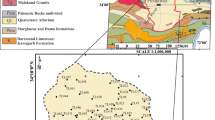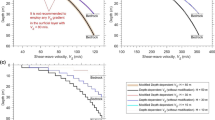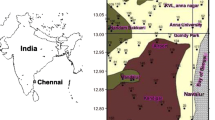Abstract
Site response characteristics have a significant influence on ground motion vibrations. To evaluate the site response effects at King Saud University campus, the horizontal-to-vertical spectral ratio (HVSR) technique has been applied at 45 sites with about 400-m spacing. The recording time was more than 1 h at each site with a sampling rate of 100 Hz. The data were processed and analyzed using Geopsy software to produce measurements of fundamental frequency and minimum site amplification factor. Moreover, shear-wave velocity down to 30-m depth has been acquired at 10 measuring sites in the campus. In addition, geotechnical borehole data were collected from four boreholes within the campus. Generally, in majority of sites the H/V curve for amplitude spectra displayed a clear peak, signifying the presence of a sharp soil–bedrock impedance contrast between alluvial deposits and underlying bedrock. It is indicated that the fundamental frequency ranges between 0.64 and 1.94 Hz. Given the measured resonance frequency of around 1 Hz, buildings located on the alluvium that have 5 stories in height could experience soil-structure resonance, while the amplification factor varies from 1.19 to 11.22 indicating localized zones having high vulnerability index due to the considerable thickness of alluvial deposits. Moreover, shear-wave velocity ranges between 320 m/s and 684 m/s revealing zones of stiff soil to very dense soil/or soft rock which is correlated well with the geotechnical parameters of borehole data. Based on these results, the ground conditions of near-surface sediments in the King Saud University campus indicate weak zones that led to ground subsidence resulting in differential settlements of foundations.












Similar content being viewed by others
References
Abdelrahman K, Abd El-Aal A, El-Hady S, Mohamed A, Abdel-Moniem E (2012) Fundamental site frequency estimation at New Domiat city, Egypt. Arab J Geosci 5:653–661. https://doi.org/10.1007/s12517-010-0222-2
AECOM. Riyadh Metro Project Package 1: Geotechnical Interpretive Report. 2014.
Bard PY (2007) International training course on: seismology, seismic data analysis, hazard assessment and risk mitigation. Potsdam, Germany, pp 17–22
Barton NR, Lien R, Lunde J (1974) Engineering classification of rock masses for the design of tunnel support. Rock Mech 6(4):189–236
Boore DM (2013) The uses and limitations of the square-root-impedance method for computing site amplification. Bull Seismol Soc Am 103(4):2356–2368. https://doi.org/10.1785/0120120283
Deere DU (1989) Rock quality designation (RQD) after 20 years, U.S. Army Corps Engrs. Contract Report GL-89-1. Vicksburg, MS: Waterways Experimental Station.
Dunand F, Bard P Y, Chatelain J L, Guéguen P, Vassail T and Farsi M N (2002) Damping and frequency from random method applied to insitu measurements of ambient vibrations: evidence for effective soil structure interaction. 12th European Conference on Earthquake Engineering, London. p. 869.
El-Asa‘ad G (1984) The paleobiogeographic distribution of the Late Cretaceous fauna of Arabia and surrounding areas. Arab Gulf J Sci Res 2(1):105–121
Fnais MS, Abdelrahman K, Al-Amri AM (2010) Microtremor measurements in Yanbu city of Western Saudi Arabia: A tool for seismic microzonation. Journal of King Saud University - Science 22(2):97–110
Konno K, Ohmachi T (1998) Ground-motion characteristics estimated from spectral ratio between horizontal and vertical components of microtremors: Bulletin of the Seismological Society of America 88, p. 228–241.
Lucian C, Wangwe EM (2013) The usefulness of rock quality designation (RQD) in determining strength of the rock. Int Refereed J Eng Sci 2(9):36–40
Manivit J, Pellaton C, Vaslet D, Le Nindre YM, Brosse JM, Breton JP, Fourniguet J (1985) Geologic map of the Darma’ quadrangle, sheet 24 H, Kingdom of Saudi Arabia (with text): Saudi Arabian Deputy Ministry for Mineral Resources, Jeddah, Geoscience Map GM-101A.
Meyerhof G (1956) Penetration tests and bearing capacity of cohesionless soils. J Soils Mechanics and Foundation Division ASCE, 82(SM1).
Noor M, Daud M (2016) Determination of soil thickness based on natural frequency using microtremor measurement. ARPN Journal of Engineering and Applied Sciences. 11(8): 5342–5346
Powers RW (1966) Geology of the Arabian Peninsula. Sedimentary geology of Saudi Arabia. U.S, Geological Survey Professional Paper
Powers RW (1968) Lexique stratigraphique international: Saudi Arabia: vol. III, Asie, fasc. 10 b 1: Centre National de la Recherche Scientifique, Paris, 177 p.
SESAME Project (2004) Site effects using ambient excitations. URL: http://sesame-fp5.obs.ujf-grenoble.en. Accessed on May 1, 2017.
Shehata H, Das B (Eds.) (2019) GeoMEast 2018, SUCI, pp. 21–39. https://doi.org/10.1007/978-3-030-01923-5_3
Soil and Foundation Company (SAFCO) report (2014) Geotechnical investigation report for the proposed KACST and KSU project, 60 p.
Susilo A, Wiyono S (2012) Frequency analysis and seismic vulnerability index by using Nakamura methods at a new artery way in Porong, Sidoarjo, Indonesia. Int J Appl Phys Math 2(4):227–230
Vaslet D, Al-Musllem M, Maddah S, Brosse JM, Foumiguet J, Breton JP, Le Nindre YM (1991) Geologic map of the Ar Riyad quadrangle, sheet 24 I, Kingdom of Saudi Arabia (without Landsat base): Saudi Arabian Deputy Ministry for Mineral Resources. Jeddah, Geoscience Map GM-121 C.
Ventura CE, Onur T, Hao Ken X.-S (2004) Site period estimations in the fraser river delta using microtremor measurements - experimental and analytical studies. 13th World Conference on Earthquake Engineering, Vancouver, Canada, August 1–6, 2004, Paper No. 1075
Vincent (2008) Saudi Arabia: an environmental overview. Taylor & Francis
Acknowledgments
Deep thanks are extended to the reviewers for their beneficial review and valuable comments.
Funding
The authors would like to extend their sincere appreciation to the Deanship of Scientific Research at King Saud University for its funding this research group No. RGP -1436-010.
Author information
Authors and Affiliations
Corresponding author
Additional information
Responsible Editor: Abdullah Al-Amri
Rights and permissions
About this article
Cite this article
Almadani, S.A., Abdelrahman, K. & Mansour, F.I.b. Site response assessment and ground conditions at King Saud University Campus, Riyadh City, Saudi Arabia. Arab J Geosci 13, 357 (2020). https://doi.org/10.1007/s12517-020-05378-8
Received:
Accepted:
Published:
DOI: https://doi.org/10.1007/s12517-020-05378-8




